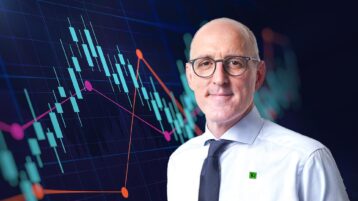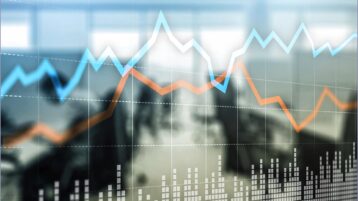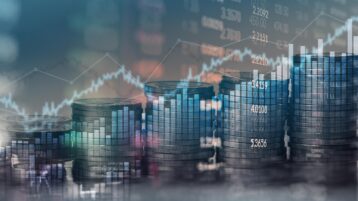Expect higher volatility, mid to high single-digit returns and continued deep sector rotations in 2022, says Michael Craig, Head of Asset Allocation, TD Asset Management. He joins Kim Parlee to make the bullish case for Canadian equities, real estate, but says it could be another challenging year for fixed income.
Print Transcript
[MUSIC PLAYING]
- There is an old adage that as the first trading week of the year goes, so goes the entire year. I don't know if we want that to come true this year. But if that theory does hold true, buckle up. It could be a tumultuous year. Here to give us his perspective, Michael Craig. He is head of asset allocation derivatives with TD Asset Management. He joins us now.
Mike, good to have you with us. Let's just start there. I mean, it has been quite the beginning, or quite the start, I should say, to the beginning of the year. We saw lots of volatility in tech stocks, generally we are down. Do you expect that sell off to continue? Do you expect it to extend to broader markets?
- Evening, Kim. I think on a more short term basis, I think the sell off is done. It was really pretty much undoing much of the end of the year rally. And the markets are just really starting to adjust to the reality that we're coming into a hiking cycle. And certain areas of froth have been taken down quite a bit. So we think that's likely passed for the time being.
KIM PARLEE: It's been a somewhat violent rotation. It feels-- and maybe just when you're going through it, it feels worse than when you get the big picture or long term perspective. But we've seen a lot of money come out of tech growth moving into value. Does that mean we're going to start to see bubbles in other areas now, like value?
MICHAEL CRAIG: No, I don't think so. I think these mini sell offs are very, very helpful. Essentially, they're there to take the froth off the market. Value, on a long term basis, has massively underperformed technology. So value is nowhere near levels that we would feel as overpriced.
Long way to go. Certainly, I'm not in the camp that I think that value is going to be the place to be for the next 10 years. But certainly, right now in the midst of a hiking cycle, strong economic growth, those stocks that have more gearing to kind of the here and now of economic momentum should do quite well. And they tend to have a much better sensitivity to interest rate rises than technology does.
- Can we talk a bit about the interest rate hikes? Because we know, of course, that the market is pricing in, I think, we've got four Fed hikes coming. But at the same time, all the inflation data that we're seeing right now is lagging big numbers. But my question to you, I guess, is are we at peak inflation? Have we actually gone through it already, or do you think there's more to come?
- Well, the Fed's out of sync with the inflation narrative. They're probably nine months behind where they should have been. And it's easy to play Monday morning quarterback. But I think the grim reality is that the central bankers have come to the realization that inflation is not transitory. And they're going to have to act sooner than later.
In terms of the acceleration of inflation, Beige Book came out today, quite consistent comments from various Fed districts and that. There was a tremendous wage pressure, labor is very tight, but that the rate of change is slowing. So my sense is for this year we've likely seen, in terms of this inflation episode, a peak. I think in the longer term, over the next 10 years, all bets are off. There's certainly some forces at play that could lead to higher inflation in the years to come.
While it be climate change, ESG, changing demographics, as well as changes in policy in terms of more focus on redistribution than on lower inflation. But for this year, my sense is that we're going to see elevated levels of inflation, but we're through the peak of it. And it should start to moderate into the second half of this year.
- And then with central banks then coming out with tightening, the Fed has been clear. Many people expecting other central banks to follow along. But can the markets withstand that? I mean, generally speaking, you would hope that part of the reason they're tightening is because inflation mean there's growth and things are heading back to normal. But I don't know, the markets, they certainly don't like rising rates.
- So we're starting at 0 interest rates and tremendous quantitative easing. So that's our starting point. I guess there's two ways to answer that question. One, if you think back to 2018, the Fed continued to hike into 2 and 1/2%, and then the market's really, really reacted violently. But that was at the tail end of that hiking cycle. Things we need to watch for is the pace. And so if they accelerate their hiking cycle, if they come in and do 50 or 75 basis points, which would not be our expectation But if they were to do that, would create a tremendous amount of volatility.
And so depending on how they pace it out is really important. This is a really, really, really tight, tight act to follow. Because they are facing tremendous political pressure to address inflation. At the same time, I think they're fine with the market sell off 5% or 10%, but they certainly don't want to create a bear market in financial assets. And so this is really going to be critical to see the pace of change.
I don't think that they're going to go exceptionally faster than the market's expecting this year. If we see four or five hikes, I think that'd probably be about right. But we'll see. We'll wait and see. And ultimately, we're going to lift off likely in March and we'll see where we go from there.
- Can you give us a sense of what your call is right now for equities, fixed income, and alternatives? Let's start with equities. What do you see?
- So our thoughts are for this year that equity returns are going to moderate materially. 2021 was a phenomenal year for stocks. This year, I wouldn't be surprised to see equity returns in the mid to higher single digit range. The other thing I would say is that last year we had limited volatility last year. I think our downtrades were between 3% and 5%.
We would expect to see some 10% pullbacks this year. So lower returns, much more volatility, much more of this rotation we've seen. And generally speaking, a positive year, but a year that's going to be a little bit more uncomfortable than it has in the past.
- Can we split up? And I should have asked about Canadian equities versus US equities.
- We're a bit more positive on Canada, which this has been a theme that we've kind of taken for some time. I still believe in it. We like the fact that Canada has a lot of financials, a lot of energy. These are sectors that tend to do well in early stage rate hiking cycle. They tend to actually almost be inversely correlated to rates. So as rates go higher, it's actually quite accretive to financials.
So we like the Canadian market. I think in terms of the pandemic, while it's a bit of a slog right now, we're in a good spot to come out of this in the spring. And I think the future is quite bright for Canada. So we like the Canadian market. In terms of other markets, we have been reducing some of our US exposure, looking for other markets.
Europe, Asia as well as Canada, to spread that risk around. Just looking for places that aren't as sensitive to rate hikes as kind of long duration technology, which has been very, very sensitive to this rate hiking cycle. Essentially, the thought process for this year is higher inflation, higher growth, and looking for a bit more value in our portfolios.
- What about-- we'll get to fix, but let's talk a bit about alternatives. Tell me how have they performed in the past little while and how do you see them performing?
- They've been rock solid and great. Love the asset class. Great diversifier in our portfolios. Have a much different return stream in terms of volatility than public markets. So quite bullish on infrastructure, a lot of demands. I think this is going to be a real thematic play for years to come.
And in real estate, after what was a challenging year in 2020, seeing that bounce back nicely. Now, when we talk about real estate, we're talking about distribution centers, office buildings, apartment buildings, industrials, et cetera. So across the whole spectrum. But like these areas. Expect returns to be, on the real estate side, 4% to 5%. In infrastructure, a bit more risk, but we expect returns more in the 7 to 8. And then commercial mortgage is kind of a 2 to 3, which isn't a lot, but in a world of very low and depressed interest rates is not too bad, as far as a fixed income alternative.
- Well, let's talk about the fixed income alternative. What are you seeing?
- Well, fixed income was a tough market last year. Broadly speaking, outside of high yield, which had a great year, fixed income posted negative returns in 2021. Our sense is there's been a lot more value baked in. I still think that fixed is a little bit expensive, but not nearly-- yields aren't nearly as depressed as they were a year ago.
For 2021, you know, coupon like returns. If we can get out of this year at 1 and a 1/2%, 2% returns to fixed income, I would call that a win. Again, rate volatility is here. We're going to see a lot of vol. And I think one message I would say is that for the years to come, beta, or just holding an asset is not going to give you great returns. But with this increased volatility, alpha is going to be far more valuable.
So I think the distribution of returns from fixed income will be quite wide next year, as certain managers are able to harness those opportunities and some not do as well. So a lot more distribution of returns this year. But ultimately, as a core market, 1 and 1/2%, 2% I think it's fair.
- Certainly a good thing for active management in terms of the alpha side of things. Can I ask you, what are the risks of a bear market? And I mean, I have to say that I guess depending on which asset class we're talking about. But let's talk about equities for 2022. I mean, you did say expect some volatility, you could see some big drops. But if the Fed missteps, something else happens, what are you keeping your eye on?
- So from a financial markets perspective, I think the biggest source of risk is financial conditions tightening faster than expectations. And you can look at that in terms of real interest rates, it's a bit wonky. But essentially, a bond is broken into the inflation component and the real component. As real rates go higher, that's a measure of financial conditions tightening. And if they go too far, too fast, that sets up a really bad environment for both stocks and bonds.
We've seen a little bit of that in the last couple of weeks. Not awful, but it's a taste of what could happen if you see a much more activist Fed, a much more aggressive rate hiking cycle, you're going to get tons of currency vol, tons of rate vol, and that will also lead into equity markets. Not the end of the world, but does create a backdrop where you could see some material down trades. So that would be one area of risk this year.
The second area-- now, we've become a little bit more sanguine towards China. It's pretty bummed out. A lot of managers are underweight China now in the equity side. Tons of headline risk that's come out of there. But I think it's all fairly priced. One area of risk that you could see is as China opens up, they haven't had the same experience with COVID other areas have. They've had this Zero-COVID policy.
Most of us in developed markets have either had vaccinated or had COVID or had both, so we are building antibodies. That hasn't been the same story in China. And so if they do, after the Olympics, open up on scale, and you start to see they start to abandon that Zero-COVID policy, you could see tremendous hospitalizations, deaths, material impacts to supply chains and general chaos in that market, if that is to occur. So that would be a risk, that a bit of a dark one. But something I think people-- COVID is not done with us. As much as we'd like to be done with COVID, it's not done with us. And I think these are some of the surprises we need to think about into 2022.
- It's a great outlook. And again I do-- I hope we're done with COVID. I hope it's done with us. But again, time will tell. And we're seeing all the time. Mike, always great to have you on. Thanks so much.
- Thank you for having me, Kim.
[MUSIC PLAYING]
- There is an old adage that as the first trading week of the year goes, so goes the entire year. I don't know if we want that to come true this year. But if that theory does hold true, buckle up. It could be a tumultuous year. Here to give us his perspective, Michael Craig. He is head of asset allocation derivatives with TD Asset Management. He joins us now.
Mike, good to have you with us. Let's just start there. I mean, it has been quite the beginning, or quite the start, I should say, to the beginning of the year. We saw lots of volatility in tech stocks, generally we are down. Do you expect that sell off to continue? Do you expect it to extend to broader markets?
- Evening, Kim. I think on a more short term basis, I think the sell off is done. It was really pretty much undoing much of the end of the year rally. And the markets are just really starting to adjust to the reality that we're coming into a hiking cycle. And certain areas of froth have been taken down quite a bit. So we think that's likely passed for the time being.
KIM PARLEE: It's been a somewhat violent rotation. It feels-- and maybe just when you're going through it, it feels worse than when you get the big picture or long term perspective. But we've seen a lot of money come out of tech growth moving into value. Does that mean we're going to start to see bubbles in other areas now, like value?
MICHAEL CRAIG: No, I don't think so. I think these mini sell offs are very, very helpful. Essentially, they're there to take the froth off the market. Value, on a long term basis, has massively underperformed technology. So value is nowhere near levels that we would feel as overpriced.
Long way to go. Certainly, I'm not in the camp that I think that value is going to be the place to be for the next 10 years. But certainly, right now in the midst of a hiking cycle, strong economic growth, those stocks that have more gearing to kind of the here and now of economic momentum should do quite well. And they tend to have a much better sensitivity to interest rate rises than technology does.
- Can we talk a bit about the interest rate hikes? Because we know, of course, that the market is pricing in, I think, we've got four Fed hikes coming. But at the same time, all the inflation data that we're seeing right now is lagging big numbers. But my question to you, I guess, is are we at peak inflation? Have we actually gone through it already, or do you think there's more to come?
- Well, the Fed's out of sync with the inflation narrative. They're probably nine months behind where they should have been. And it's easy to play Monday morning quarterback. But I think the grim reality is that the central bankers have come to the realization that inflation is not transitory. And they're going to have to act sooner than later.
In terms of the acceleration of inflation, Beige Book came out today, quite consistent comments from various Fed districts and that. There was a tremendous wage pressure, labor is very tight, but that the rate of change is slowing. So my sense is for this year we've likely seen, in terms of this inflation episode, a peak. I think in the longer term, over the next 10 years, all bets are off. There's certainly some forces at play that could lead to higher inflation in the years to come.
While it be climate change, ESG, changing demographics, as well as changes in policy in terms of more focus on redistribution than on lower inflation. But for this year, my sense is that we're going to see elevated levels of inflation, but we're through the peak of it. And it should start to moderate into the second half of this year.
- And then with central banks then coming out with tightening, the Fed has been clear. Many people expecting other central banks to follow along. But can the markets withstand that? I mean, generally speaking, you would hope that part of the reason they're tightening is because inflation mean there's growth and things are heading back to normal. But I don't know, the markets, they certainly don't like rising rates.
- So we're starting at 0 interest rates and tremendous quantitative easing. So that's our starting point. I guess there's two ways to answer that question. One, if you think back to 2018, the Fed continued to hike into 2 and 1/2%, and then the market's really, really reacted violently. But that was at the tail end of that hiking cycle. Things we need to watch for is the pace. And so if they accelerate their hiking cycle, if they come in and do 50 or 75 basis points, which would not be our expectation But if they were to do that, would create a tremendous amount of volatility.
And so depending on how they pace it out is really important. This is a really, really, really tight, tight act to follow. Because they are facing tremendous political pressure to address inflation. At the same time, I think they're fine with the market sell off 5% or 10%, but they certainly don't want to create a bear market in financial assets. And so this is really going to be critical to see the pace of change.
I don't think that they're going to go exceptionally faster than the market's expecting this year. If we see four or five hikes, I think that'd probably be about right. But we'll see. We'll wait and see. And ultimately, we're going to lift off likely in March and we'll see where we go from there.
- Can you give us a sense of what your call is right now for equities, fixed income, and alternatives? Let's start with equities. What do you see?
- So our thoughts are for this year that equity returns are going to moderate materially. 2021 was a phenomenal year for stocks. This year, I wouldn't be surprised to see equity returns in the mid to higher single digit range. The other thing I would say is that last year we had limited volatility last year. I think our downtrades were between 3% and 5%.
We would expect to see some 10% pullbacks this year. So lower returns, much more volatility, much more of this rotation we've seen. And generally speaking, a positive year, but a year that's going to be a little bit more uncomfortable than it has in the past.
- Can we split up? And I should have asked about Canadian equities versus US equities.
- We're a bit more positive on Canada, which this has been a theme that we've kind of taken for some time. I still believe in it. We like the fact that Canada has a lot of financials, a lot of energy. These are sectors that tend to do well in early stage rate hiking cycle. They tend to actually almost be inversely correlated to rates. So as rates go higher, it's actually quite accretive to financials.
So we like the Canadian market. I think in terms of the pandemic, while it's a bit of a slog right now, we're in a good spot to come out of this in the spring. And I think the future is quite bright for Canada. So we like the Canadian market. In terms of other markets, we have been reducing some of our US exposure, looking for other markets.
Europe, Asia as well as Canada, to spread that risk around. Just looking for places that aren't as sensitive to rate hikes as kind of long duration technology, which has been very, very sensitive to this rate hiking cycle. Essentially, the thought process for this year is higher inflation, higher growth, and looking for a bit more value in our portfolios.
- What about-- we'll get to fix, but let's talk a bit about alternatives. Tell me how have they performed in the past little while and how do you see them performing?
- They've been rock solid and great. Love the asset class. Great diversifier in our portfolios. Have a much different return stream in terms of volatility than public markets. So quite bullish on infrastructure, a lot of demands. I think this is going to be a real thematic play for years to come.
And in real estate, after what was a challenging year in 2020, seeing that bounce back nicely. Now, when we talk about real estate, we're talking about distribution centers, office buildings, apartment buildings, industrials, et cetera. So across the whole spectrum. But like these areas. Expect returns to be, on the real estate side, 4% to 5%. In infrastructure, a bit more risk, but we expect returns more in the 7 to 8. And then commercial mortgage is kind of a 2 to 3, which isn't a lot, but in a world of very low and depressed interest rates is not too bad, as far as a fixed income alternative.
- Well, let's talk about the fixed income alternative. What are you seeing?
- Well, fixed income was a tough market last year. Broadly speaking, outside of high yield, which had a great year, fixed income posted negative returns in 2021. Our sense is there's been a lot more value baked in. I still think that fixed is a little bit expensive, but not nearly-- yields aren't nearly as depressed as they were a year ago.
For 2021, you know, coupon like returns. If we can get out of this year at 1 and a 1/2%, 2% returns to fixed income, I would call that a win. Again, rate volatility is here. We're going to see a lot of vol. And I think one message I would say is that for the years to come, beta, or just holding an asset is not going to give you great returns. But with this increased volatility, alpha is going to be far more valuable.
So I think the distribution of returns from fixed income will be quite wide next year, as certain managers are able to harness those opportunities and some not do as well. So a lot more distribution of returns this year. But ultimately, as a core market, 1 and 1/2%, 2% I think it's fair.
- Certainly a good thing for active management in terms of the alpha side of things. Can I ask you, what are the risks of a bear market? And I mean, I have to say that I guess depending on which asset class we're talking about. But let's talk about equities for 2022. I mean, you did say expect some volatility, you could see some big drops. But if the Fed missteps, something else happens, what are you keeping your eye on?
- So from a financial markets perspective, I think the biggest source of risk is financial conditions tightening faster than expectations. And you can look at that in terms of real interest rates, it's a bit wonky. But essentially, a bond is broken into the inflation component and the real component. As real rates go higher, that's a measure of financial conditions tightening. And if they go too far, too fast, that sets up a really bad environment for both stocks and bonds.
We've seen a little bit of that in the last couple of weeks. Not awful, but it's a taste of what could happen if you see a much more activist Fed, a much more aggressive rate hiking cycle, you're going to get tons of currency vol, tons of rate vol, and that will also lead into equity markets. Not the end of the world, but does create a backdrop where you could see some material down trades. So that would be one area of risk this year.
The second area-- now, we've become a little bit more sanguine towards China. It's pretty bummed out. A lot of managers are underweight China now in the equity side. Tons of headline risk that's come out of there. But I think it's all fairly priced. One area of risk that you could see is as China opens up, they haven't had the same experience with COVID other areas have. They've had this Zero-COVID policy.
Most of us in developed markets have either had vaccinated or had COVID or had both, so we are building antibodies. That hasn't been the same story in China. And so if they do, after the Olympics, open up on scale, and you start to see they start to abandon that Zero-COVID policy, you could see tremendous hospitalizations, deaths, material impacts to supply chains and general chaos in that market, if that is to occur. So that would be a risk, that a bit of a dark one. But something I think people-- COVID is not done with us. As much as we'd like to be done with COVID, it's not done with us. And I think these are some of the surprises we need to think about into 2022.
- It's a great outlook. And again I do-- I hope we're done with COVID. I hope it's done with us. But again, time will tell. And we're seeing all the time. Mike, always great to have you on. Thanks so much.
- Thank you for having me, Kim.
[MUSIC PLAYING]



























